Where is Oman?
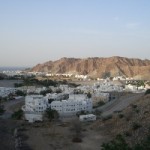
Ruwi looking to Muscat Bay
Muscat is a sparkling white low-rise gem strung along the Gulf of Oman backed by amazing mountains. This dramatically-located capital and travel destination is called the ‘Jewel of Arabia’ and here is what guest writer Julie Wise perceived as 7 areas you must visit in Muscat as part of your Omani adventure – no particular order.
1. Ruwi
Ruwi is the cosmopolitan and modern quarter where the commercial activities of the city are undertaken. Muscat has a strict building code of 8 stories max and traditional Arabic architectural influences must be included in every building (there is a 12-storey Sheraton built prior which is under restoration to compile with these rules). The result is a place with its own distinctive flavour, one that has modern comforts whilst honouring its beautiful heritage. A splendid example is the Bank of Oman building. These gold doors are just a hint of what is inside the foyer and yes you can enter it. Do try it.
The Sultan’s Armed Forces Museum which provides a great insight into Oman’s fascinating military and political history is located in150 year old Bait Al Falaj fort behind the Ministry of Information. Don’t be put off by the guarded entrance – it is a working military base – the museum is open to visitors and included in the entrance price is a private escort around the museum. Not to be missed is their photo collection of Muscat in 1975 and the same shots taken again in 2006. There is a vast array of exhibits so you can spend quite some time there. The museum closes at 1pm.
2. Old Muscat
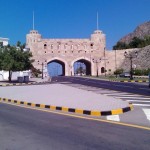
City Gate to Old Muscat
Old Muscat is where you’ll find the historical area and govt buildings. Bait al Zubair Museum – showcases the cultural history and tradition of Oman. The museum displays include Omani jewellery, costume, dress, household items and Omani weapons including many styles of the Khanjar. Apart from the museum there is a book house and an Omani town house located within the premises where there is a rich collection of works of art and artefacts, originally owned by the founding family, including a room dedicated to paintings of Omani cartography.
Also in Old Muscat is the Sultan’s ceremonial palace Al Alam Palace. Built in 1972 it has a facade of gold and blue. Behind the palace is beautiful Muscat Bay where you can view the splendour of the Mirani and Jalali Forts which surround the palace. The palace is not open to visitors but entry to Jalali Fort can at times be arranged through the govt ministry office.
Exiting Old Muscat you’ll pass through the Old City gates which are built on the mountain Outcrop that once defined the boundary of Muscat city.
3. The Corniche
Once you pass the gates you’ll begin your ‘cruise’ along the corniche. Here you’ll pass a series of lookouts and parks where locals and tourists alike stroll along appreciating the cool evening breezes that come from the Gulf of Oman. Each of these parks has a particular defining feature such as lights throwing colour onto the rocky outcrops, fountains and in Riyam Park a watchtower built to resemble an incense burner.
4. Muttrah
The Corniche finishes at Muttrah Harbour. You can arrange a harbour trips by traditional dhow or admire the yachts that may be berthed there – including the Royal Yacht and its supply vessel.
However, Muttrah’s real attraction is the traditional souq. The souq comprises areas for 3 distinct shopping – Fish Market (which has its own dedicated roundabout with a fish built on it), the Fruit & Vegetable souq and the ancient Arabian marketplace to buy just about everything else you would need. The Fish & F&V markets operate first in the morning and are generally finished by 11am.
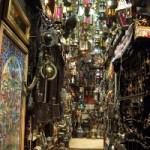
Muttrah Souk
The Arabian souq also starts in the morning but it trades through the day until about 11pm(ish). This souq will take you into a world where time stands still. There are rows and rows of shops selling spices, perfumes, gold, incense, textiles and artefacts making up this labyrinth. You will lose yourself both literally and in time. The Frankincense wafts from burners at the front of some of the shops while countless pieces of Omani silver adorn the walls of others. Apart from shopping, you literally spend your time soaking up the atmosphere, wandering around and immersing in the sights, sounds and smells of the place.
Its trade in the same way it has been for thousands of years. Bargaining is a must, however. Gold and silver are well priced and mainly sold by weight. Good buys are silver khanjars (the traditional Omani dagger, worn by men) and incense burners. Go at night from 6pm, the earlier day trade is mainly for less adventurous tourists and very few locals go so it lacks the colour, expert haggling and the sense of magic.
On the promenade outside the souq’s entrance you can eat a good local meal and simply watch it all pass before your eyes. (Tip: if a cruise boat is in the harbour avoid the souq, prices are known to rise)
5. The Sultan Qaboos Grand Mosque
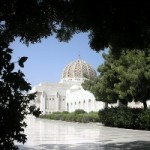
The Grand Mosque
Without doubt the Sultan Qaboos Grand Mosque is unique. The only way to photograph it is to stand across the 8-lane highway. The Mosque complex covers 40,000 square metres so yes its size is grand. In fact everything is biggest this, biggest that, bigger than, only one in the world etc. Here are 3 of its facts – It holds 20,000 worshippers when the Prayer Hall, courtyard and Women’s Hall are opened into a connected space, a 14 metre Swarovski crystal chandelier with gold-plated metalwork hangs in the Prayer Hall and the Persian Rugs were weaved especially for the Mosque by 600 weavers over 4years.
That all said this place is stunningly beautiful in its design, simplicity and functionality. Its tranquil rose and frangipani gardens help give the Grand Mosque its purpose – a place of prayer and reflection. In my opinion this complex ranks up there with the best in the world. My ‘churched-out’ husband declared that for him it ranks above St Peters Rome & St Pauls London and possibly the Louvre.
Visitors are allowed between 8am & 11am Sat- Wed. Men can wear t-shirts but no shorts. Women need to be covered head-to-toe. They will provide pashminas and help you cover as required at the entrance. Shoes need to be taken off to enter any of the prayer halls which are open to all but children under 10. Water is allowed to be carried & it’s wise to do so. Photography is also allowed throughout the complex – including the Library.
6. Amouage
This is a special treat for both men and women. Amouage is one of the world’s most exclusive parfums and is considered the gift of kings. The factory is in Muscat’s suburbs and they do receive visitors. You tour the very small factory where everything is still hand-made – including measuring the parfum into its bottle. My husband, a frequent visitor to Oman, had brought me Amouage previously. I was so excited to actually meet the young girl who had wrapped my parfum as every bottle is signed by the person who applies the seal. They will even choose a blend to suit you. Be warned, you won’t leave empty-handed but you will leave light of wallet.
7. The Beach
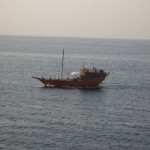
Muttrah Harbour
Sounds strange doesn’t it but Oman has some spectacular beaches and many of them are in Muscat itself. My pick would be Shatti Al-Qurum beach near the major hotels. The beach is gorgeous – pristine and peaceful with cool clean waters. Take a dip in the sea to feel cool water splash against your warm skin but be warned the sun is brutal so take whatever precautions you need. Late in the afternoon you’ll find the locals out enjoying the coolness, playing football or volleyball as relaxation or exercise. Just a 2 minute walk from the beach is a little plaza with ice cream stores, cafes (including a branch of Darcy’s) and the all too familiar western chains and a movie theatre. Also on Friday evenings this is where the ‘cool dudes’ hang out with their Ferraris, Lamborghinis and other supercars
A visit to Muscat is a rewarding and perhaps a surprisingly rich experience for those enjoy a healthy dash of culture and unique architecture with an abundance of friendly locals waiting to help you at every opportunity.
Hopefully you have enjoyed this quick snapshot of Muscat. I would love to come back and share the rest of Oman with you. It is truly a beautiful travel destination.
An essential guide to Oman
Map
TravelTipsPlus Google Map of Oman
You Might Also Enjoy The Following Travel Destinations
Muscat, Oman
Hurghada, Egypt
Aswan, Egypt
Petra, Jordan
Pamukkale,Turkey










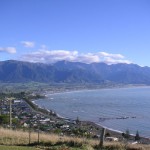
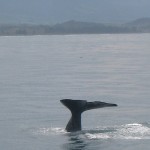

 Entries (RSS)
Entries (RSS)